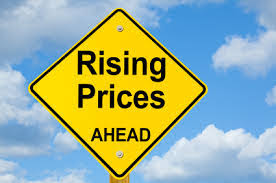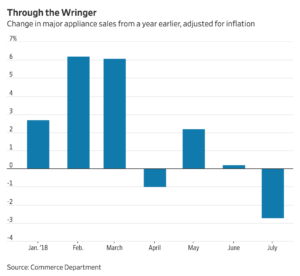(Editor Note: Insight Bytes focus on key economic issues and solutions for all of us, on Thursdays we spotlight in more depth Solutions to issues we have identified. Fridays we focus on how to build the Common Good. Please right click on images to see them larger in a separate tab. Click on the Index Topic Name at the beginning of each post to see more posts on that topic on PC or Laptop.)

Image: powertime.co.za
The tariffs applied last year sheltered the U.S. appliance industry for washers and dryers. What happened is a case study for what is likely to happen in other sheltered industries. Retailers rushed shipments of appliances prior to the tariffs going into effect. Prices were slashed sales went up, bringing demand forward in April. By July of this year sales are down almost 3%. While appliance sales falling can be partly explained by the slowdown in housing sales, this trend does not explain the price increases buyers in the market did experience. Samsung and LG competing with U.S. manufacturers, GE and Whirlpool, increased prices from 4 – 8 % on their models due to the tariffs. U.S. manufacturers raised their prices as well, so consumers ended up paying more anyway. If anything, prices should have been going down with fewer buyers in the market, instead there was a distorted market.

Sources: Department of Commerce, The Wall Street Journal – 9/18/19
The South Korean manufacturers have already made permanent moves to end the price challenge with Samsung producing appliances in a plant near Newbury County, South Carolina beginning this past January. LG is following suit, by opening a plant near Clarksville, Tennessee this fall.
So, what has happened is consumers will pay more for appliances, and jobs will come to the U.S. which the tariffs may have intended. Consumers are paying the price of the switch and it is not clear if the consumer will be better off.
Next Steps:
With the U.S. manufacturers depending on tariff shelter protection, they may not be as competitive as they could be with their competition coming on shore to take them on from a U.S. staging point. Certainly, with plants in the U.S. there is a level playing field for all the appliance companies. Consumers are likely to pay to find out which manufacturer is best and will be around 5 years from now.
We don’t like to see the federal government picking winners and losers in the marketplace. Capitalism, entrepreneurship and innovation should take over providing the best products at the lowest price for consumers. We prefer to see the government ensuring there is a level playing field and true competition. Time will tell us if the tariff move was an good one for consumers and the economy.
